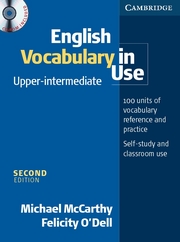Although there are tons of English vocabulary books on the market, a problem that many students learning English as a second language face is that practicality is compromised by advanced words. Vocabulary in Use, published by Cambridge University Press, attempts to bypass that problem by directly targeting learners who wish to learn words that enter the everyday language of English speakers.
The book is organized in a logical order to help students achieve fluency in colloquial English lexicon. Hence, the first section of the book is aptly named: “strategies for learning vocabulary.” This part immediately caught my attention, as it was rather unusual for a vocabulary book to specifically instruct a student how to study. The book recognizes that “There are many words in English that you don’t need at all,” and that “There are other words you need simply to understand when you read or hear them.” It then tells the student: “There are words that you need to be able to use yourself,” which, yes, the book focuses on. In the aforementioned first section, the book continues to advise the student how to use mnemonic devices, notebooks, dictionaries, and other means of learning and reinforcing vocabulary. This seemed like a very nice introduction for students using this book before proceeding to the rest of the book, as well as an appropriate guide for a teacher, should a student have one, to follow when teaching.
"The book suggests various methods to study words and provides a multitude of topics with which students can practice. It impeccably serves its stated purpose."
From that point, the book continues in an orderly fashion, with sections such as “Word formation,” “Countable and uncountable nouns,” “Notional concepts,” “Feelings and actions,” etc. divided into several units. Each unit consists of explanations, examples and challenging exercises. For me, the exercises were the strongest element of the book. Although each unit is extremely varied in content and format from each other; for example, the plural noun unit is filled with images and diagrams, while the abstract noun unit is filled simply with a list of words. The crime unit gives a bunch of examples for each keyword, while the money and finance unit is essentially a reading passage, as one could see the exercises complement the lessons very well.
The book places special emphasis on the application of words in a real life context, which is absolutely crucial in learning vocabulary. Sometimes the exercises are basic fill-in-the-blank types, which are not to be discredited, but what impressed me were other more creative ones, like one which asked the student to change the name of a country to a nationality based on the stressed syllable (e.g. Egypt to Egyptian, Vietnam to Vietnamese). Another question that I remember asks the student to identify the labor field that certain occupations would be in, such as bricklayer being in construction or a dental hygienist being in health care. Granted, the exercises for each unit are limited to a page, but the detail and intensity of the exercises is a great way of reinforcing each concept.

One shortcoming that I felt in this otherwise great book was that it seemed to reach for breadth rather than depth. Undoubtedly, English has one of the most expansive vocabularies of any language, but seeing that this book contains 100 separate units, each arguably distinct from each other in topic, students may have a hard time digesting all the information. What this means is that while the content of the book is highly recommended, it may simply take a long time for a student to learn all the words and actually retain the information. This focus on breadth also inhibits the length of individual units, which goes back to my observation that the exercises for each unit are limited to a page. Vocabulary in Use is in fact a series, and there are several variants such as Vocabulary in Use Basic, Intermediate, Advanced, etc. so conserving the breadth of the series itself may have been a better choice.
Although the content might be a bit overwhelming, Vocabulary in Use is an excellent guide for students learning English who wish to expand their vocabulary and reinforce their English skills in a practical setting. The book suggests various methods to study the words, and provides a multitude of topics with which students can practice. I believe that this book impeccably serves its stated purpose, to help students improve their English vocabulary and learn how words are used, and heartily recommend it to anyone looking to expand their vocabulary. It also looks like a great choice for English teachers who are seeking a book that can provide a clear outline for lesson plans.




